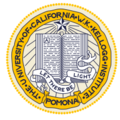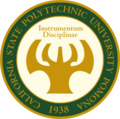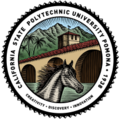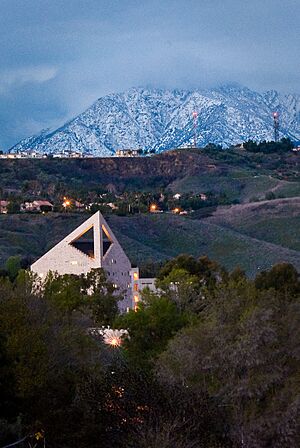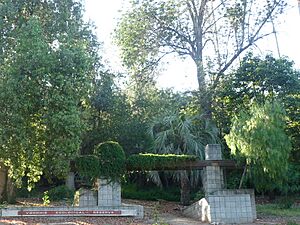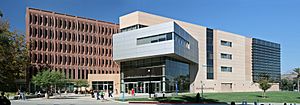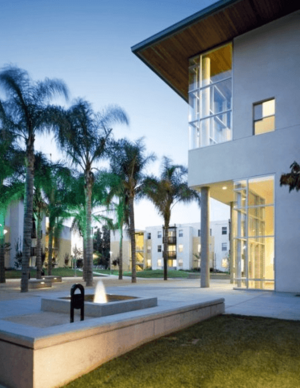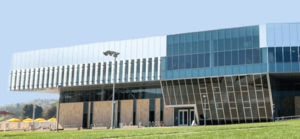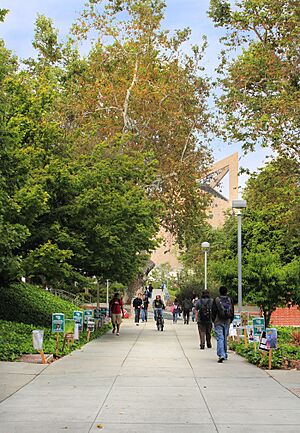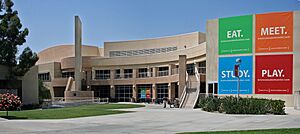California State Polytechnic University, Pomona facts for kids
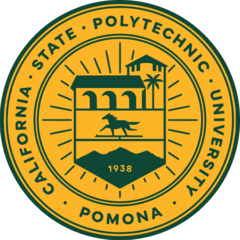 |
|
|
Former name
|
California Polytechnic School Vorhees Unit (1938–1956) California Polytechnic School Kellogg-Vorhees Unit (1956–1966) California State Polytechnic College, Kellogg-Voorhees (1966–1972) |
|---|---|
| Motto | Discere Faciendo (Latin) |
|
Motto in English
|
"Learn by Doing" |
| Type | Public polytechnic university |
| Established | 1938 |
|
Parent institution
|
California State University |
| Accreditation | WSCUC |
|
Academic affiliations
|
Space-grant |
| Endowment | $186.7 million (2024) |
| President | Iris S. Levine (interim) |
| Provost | Terri Gomez |
|
Academic staff
|
1,512 (fall 2021) |
| Students | 27,196 (fall 2024) |
| Undergraduates | 25,255 (fall 2024) |
| Postgraduates | 1,941 (fall 2024) |
| Location |
,
United States
34°03′23″N 117°49′18″W / 34.05639°N 117.82167°W |
| Campus | Large suburb, 1,438 acres (582 ha) |
| Newspaper | The Poly Post |
| Colors | Green and gold |
| Nickname | Broncos |
|
Sporting affiliations
|
NCAA Division II – CCAA |
| Mascot | Billy Bronco |
California State Polytechnic University Pomona (often called Cal Poly Pomona or CPP) is a large public university in Pomona, California. It's known for its focus on technical arts and applied sciences, meaning students learn by doing. It's the biggest of the three polytechnic universities in the California State University system, based on how many students attend.
Cal Poly Pomona started in 1938 as a southern campus of Cal Poly San Luis Obispo. This happened after Charles and Jerry Voorhis donated their school and farm in San Dimas, California. The campus grew even more in 1949 when it received Will Keith Kellogg's horse ranch, which became the W.K. Kellogg Institute of Animal Husbandry. Cal Poly Pomona became its own independent university in 1966.
Today, Cal Poly Pomona offers many different study programs. Students can earn bachelor's degrees in 94 subjects and master's degrees in 39 programs. The university also offers teaching credentials and a doctorate degree. Cal Poly Pomona is a special type of university called a polytechnic university. This means it focuses on teaching practical skills and applied sciences.
The university's sports teams are called the Cal Poly Pomona Broncos. They play in NCAA Division II as part of the California Collegiate Athletic Association (CCAA). The Broncos have 10 sports teams and have won 14 national championships. Some Cal Poly Pomona athletes have even won Olympic medals!
Contents
History of Cal Poly Pomona
The story of Cal Poly Pomona began in 1938. The Voorhis School for Boys, located near San Dimas, was acquired by the California Polytechnic School from San Luis Obispo, California.
The California Polytechnic School (now Cal Poly San Luis Obispo) started in 1901 as a vocational high school. The Voorhis School, founded in 1928, was a private school for boys who needed help. It taught practical skills and had a Christian focus. Due to money problems during the Great Depression, the Voorhis family transferred the school to Cal Poly San Luis Obispo in 1938.
The Voorhis School became the Cal Poly-Voorhis Unit. It started offering college-level courses, similar to Cal Poly San Luis Obispo. The horticulture program was moved to this new campus. Both campuses worked together under the same leader, Julian McPhee.
During World War II, many students joined the military, and the campus closed in 1943. It reopened after the war and moved to Will Keith Kellogg’s former horse ranch in Pomona, California in 1956. To honor its new home, the campus changed its name to Cal Poly Kellogg-Voorhis Unit. It offered six programs in agriculture.
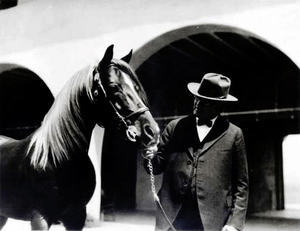
In 1957, the first class at the new Pomona campus graduated. That same year, the College of Engineering was started, becoming the second main academic area after the College of Agriculture. In 1961, the two Cal Poly campuses joined the new California State College system. For the first time, 329 female students were admitted to Cal Poly Kellogg-Voorhis Unit.
When President McPhee retired in 1966, Cal Poly split into two separate universities. However, the two campuses still work together on the annual Cal Poly Universities Rose Float.
In 1966, Cal Poly Kellogg-Voorhis changed its name to "California State Polytechnic College, Kellogg-Voorhis." It became the 16th campus to join the California State College system. Robert C. Kramer became the first president of the independent campus. On June 1, 1972, the university officially became "California State Polytechnic University, Pomona," which is its name today.
Cal Poly Pomona continued to grow in the late 1900s and early 2000s. New buildings were constructed, and programs like the Lyle Center for Regenerative Studies and the I-Poly High School were added.
University Name
The official name of the university is "California State Polytechnic University, Pomona." It is also known as "Cal Poly Pomona" or "CPP." The name "Cal Poly" is legally protected for California Polytechnic State University in San Luis Obispo.
To avoid confusion and respect each university's unique identity, it's best to use "Cal Poly Pomona" or "CPP" when talking about this university. This shows that Cal Poly Pomona is its own important school within the California State University (CSU) system.
- Former seals and logos
-
Former seal used by the university during the University of California years (1932–1943)
Campus Life and Location
Cal Poly Pomona is located in Pomona, California, a city near Los Angeles. The campus is very large, covering about 1,725 acres (698 ha). This makes it the second largest campus in the California State University system. The university also has other facilities in Southern California, like a ranch in Santa Paula, California.
The buildings on campus have different styles and ages. Some, like the Kellogg Horse Stables and Kellogg House, were built in the 1920s and show a Spanish architectural style. Others, like parts of the library, are more modern. The Manor House is where the university president lives.
Fun places on campus include a beautiful rose garden and a Japanese garden built in 2003. The Collins College of Hospitality Management and Kellogg West, a hotel and conference center, are located at the center of campus. Students and faculty run a restaurant there called the Restaurant at Kellogg Ranch.
The Voorhis Ecological Reserve is a wildlife area on campus. It has many native plants and trees. Cal Poly Pomona also has the International Polytechnic High School, a high school located right on campus.
Large concrete letters spelling "CPP" are on Colt Hill, overlooking the campus. The letters "CP" were put there in 1959, and the second "P" was added in 2004 to help tell it apart from the Cal Poly campus in San Luis Obispo.
From 1993 to 2022, a unique building called the CLA Building was a main landmark. It had a futuristic design and was even featured in movies like Gattaca. However, due to safety concerns about earthquakes, the building was taken down in 2022.
Campus Facilities for Learning and Research
The W. K. Kellogg Arabian Horse Center is an important facility on campus. It helps keep Will Keith Kellogg's purebred Arabian horses and their breeding program going, as was part of the agreement when the ranch was donated. The Horse Stables also have a small library focused on horses and offices for student services.
The Innovation Village is a large research and business area on the southern part of campus. It's a partnership between the university and private companies. Big organizations like the American Red Cross and Southern California Edison have offices there. This project aims to create many jobs and bring economic benefits to the area.
Green Campus and Getting Around
Cal Poly Pomona works hard to be environmentally friendly. It aims to reduce carbon emissions and save energy. The university is part of the American College & University Presidents Climate Commitment. This means it's working towards using more renewable energy. It's also listed in The Princeton Review's Guide to 375 Green Colleges.
The Lyle Center for Regenerative Studies is a special place on campus that teaches about sustainability. It has solar-powered dorms, ponds for raising fish, and organic gardens. It even provides housing for graduate students who want to live in an environmentally friendly way. In 2010, the center became the first carbon neutral facility in the California State University system.
The campus has a free shuttle system called "Bronco Express" to help students and staff get around. There's also a "Metrolink" shuttle that connects the campus to nearby train stations. Public bus lines also serve the campus daily.
How the University is Organized
| College founding | |
|---|---|
| College |
|
|
|
|
| Agriculture |
|
| Business Administration |
|
| Education and Integrative Studies |
|
| Engineering |
|
| Environmental Design |
|
| Hospitality Management (Collins) |
|
| Letters, Arts, and Social Sciences | |
| Science | |
Cal Poly Pomona is one of three polytechnic universities in the 23-campus California State University system. The CSU system is managed by a group called the board of trustees. They make decisions about what is taught, campus plans, and money. The current leader of the CSU system is Chancellor Mildred García.
The main leader of Cal Poly Pomona is Interim President Iris S. Levine.
University Funding
Cal Poly Pomona has an financial endowment of about $186.7 million as of the 2023-24 school year. This money helps support the university for a long time. In 2010, the W. K. Kellogg Foundation gave a huge gift of $42 million to help more students from underrepresented communities get an education. This was the largest cash gift ever given to the CSU system at that time. In 2021, philanthropist MacKenzie Scott also made a very large gift of $40 million to the university.
Academics and Learning
Cal Poly Pomona is known for its "learn by doing" approach. This means that a big part of learning involves hands-on activities and applying knowledge in real-world situations.
The word "polytechnic" comes from Greek words meaning "many arts." So, a polytechnic university focuses on teaching many technical skills and applied sciences. Cal Poly Pomona's polytechnic style helps students gain practical experience and skills needed for jobs after they graduate.
The university is also recognized as a "Center of Academic Excellence" by the Department of Homeland Security and the National Security Agency (NSA). This means it has strong programs in areas important for national security. All students are encouraged to do internships and must complete a senior research project.
The Cal Poly Pomona University Library is a central place for learning and research on campus. It has over 2.4 million items and was recently renovated and expanded.
Special Programs
Cal Poly Pomona's College of Engineering is the second largest in the California State University system. It has the biggest Mechanical Engineering, Electrical Engineering, Civil Engineering, and Construction Engineering programs in the CSU. It's also the only campus to offer an Engineering Technology focus.
The university's Business Administration major is the second largest in the CSU. Its Hospitality program is one of the largest in the entire United States.
University Rankings
| Forbes | 255 |
|---|---|
U.S. News & World Report ranked Cal Poly Pomona 3rd among public universities in the western United States for 2025. It was also ranked 2nd in Top Public Schools and 2nd in Best Colleges for Veterans. The College of Engineering was ranked 10th among undergraduate engineering schools in the U.S. where doctorates are not offered.
Money Magazine ranked Cal Poly Pomona 15th in the country in 2020 for its value. Forbes magazine ranked it 273rd among the best colleges in the nation in 2019.
Cal Poly Pomona is considered a great investment for education. In 2013, it had a high return on investment (ROI) for graduates, meaning students get a good value for their education compared to the cost.
How to Get In
The Carnegie Foundation for the Advancement of Teaching and U.S. News & World Report say that getting into Cal Poly Pomona is "selective." The CSU system lists Cal Poly Pomona as one of its schools with higher admission standards for new students.
For Fall 2016, about 51.9% of students who applied were admitted. The average GPA for new students was 3.45. Students who live outside Cal Poly Pomona's closest local area (Tier 1) are ranked by their eligibility and admitted based on available space.
Student Diversity
| Race and ethnicity | Total | ||
|---|---|---|---|
| Hispanic | 54% |
|
|
| Asian | 21% |
|
|
| White | 13% |
|
|
| Two or more races | 4% |
|
|
| Unknown | 3% |
|
|
| Black | 2% |
|
|
| Foreign national | 2% |
|
|
| Economic diversity | |||
| Low-income | 46% |
|
|
| Affluent | 54% |
|
|
Cal Poly Pomona is a very diverse university, with students from many different backgrounds. It is known as a "Champions of Diversity" campus. As of 2018, it had the third highest percentage of Asian American students in the Cal State System. The university also has over 1,000 international students from other countries.
Impacted Programs
Some academic programs at Cal Poly Pomona receive more applications than they can accept. These are called "impacted" programs. For these programs, students are ranked by their eligibility, and only the top students are accepted. Some impacted programs include Aerospace Engineering, Civil Engineering, Computer Engineering, Electrical Engineering, Mechanical Engineering, Architecture, Psychology, and Biology.
Student Life and Activities
Student Housing
Cal Poly Pomona has a large on-campus housing system that can hold 3,519 students. In 2016, about 39% of new students and 10% of all students lived on campus.
There are different types of places to live on campus. The oldest are the six "Traditional Halls" like Alamitos and Aliso. Newer options include the "University Village" and the "Suites," which offer apartment-style living for students who are not freshmen.
To help students succeed, new freshmen who did not graduate from a high school in the closest local area are required to live on campus.
New residential halls called Sicomoro and Secoya, along with a new dining hall (Centerpointe Dining Commons), opened in January 2020. These new halls can house 980 first-year students.
Bronco Student Center
The Bronco Student Center is a busy place for students. It's where students can meet, attend conferences, eat, relax, and shop. The student government offices are located here, along with other student-run departments.
LGBT-Friendly Campus
Cal Poly Pomona is recognized as one of the best campuses for lesbian, gay, bisexual, and transgender (LGBT) students. The university offers gender-neutral housing, a pride center for LGBT students, and clubs like oSTEM and Pride Alliance for students and staff.
Campus News and Media
Campus events are covered by the student newspaper, The Poly Post. It started in 1940 as the Bronc's Cheer. The name changed over the years and became The Poly Post in 1962.
CPP News is the university's official online magazine. It shares news, announcements, and stories about different departments.
Bronco Pep Band
The Bronco Pep Band is a student-run band at Cal Poly Pomona. They play at athletic events to cheer on the school's teams and get the crowd excited. The band is open to all students and anyone else in the area who wants to join.
Greek Life
Greek Life at Cal Poly Pomona includes 16 fraternities and 11 sororities. These groups are managed by the Greek Council.
Rose Parade Float
Cal Poly Pomona and Cal Poly San Luis Obispo have worked together on a float for the Tournament of Roses Parade since 1949. They won an award in their very first year! This joint program is special because the floats are designed and built entirely by students from both campuses. This tradition shows the strong partnership between the two Cal Poly schools.
Athletics and Sports
Voorhis Vikings
Before the university moved to Pomona, the college had sports teams called the "Voorhis Vikings." These teams were mostly made up of boys who lived at the Voorhis School. Even with this history, the university's current sports teams are known as the Broncos.
Cal Poly Pomona Broncos
Cal Poly Pomona's sports teams, the Cal Poly Pomona Broncos, compete in the NCAA Division II. They play in the California Collegiate Athletic Association. There are 11 sports for men and women throughout the year.
The Broncos recently won a national championship in 2024 Division II Women's Soccer. They beat Minnesota State Mankato 2-1, earning their first title in that sport. The Broncos are very successful in their conference, with 74 CCAA Titles and 15 National Titles. Individual athletes from the university have also won 25 National Titles in various sports.
Team national championships for the Broncos include:
- Baseball (3): 1976, 1980, 1983
- Men's Cross Country (1): 1983
- Men's Basketball (1): 2010
- Women's Basketball (5): 1982, 1985, 1986, 2001, 2002
- Women's Soccer (1): 2024
- Women's Tennis (4): 1980, 1981, 1991, 1992
Notable People from Cal Poly Pomona
See also
 In Spanish: Universidad Estatal Politécnica de California para niños
In Spanish: Universidad Estatal Politécnica de California para niños
- California Master Plan for Higher Education



